Oral tori in a sample of the Spanish university students: prevalence ...
Oral tori in a sample of the Spanish university students: prevalence ...
Oral tori in a sample of the Spanish university students: prevalence ...
You also want an ePaper? Increase the reach of your titles
YUMPU automatically turns print PDFs into web optimized ePapers that Google loves.
<strong>Oral</strong> <strong>tori</strong> <strong>in</strong> a <strong>sample</strong> <strong>of</strong> <strong>the</strong> <strong>Spanish</strong> <strong>university</strong> <strong>students</strong>:<br />
<strong>prevalence</strong> and morphology<br />
Virg<strong>in</strong>ia Galera, Josefa María Moreno, Esperanza Gutiérrez<br />
Departamento de Zoología y Antropología Física<br />
Facultad de Biología, Universidad de Alcalá<br />
28871 Alcalá de Henares, (Madrid) España<br />
virg<strong>in</strong>ia.olmo@uah.es<br />
Abstract <strong>Oral</strong> <strong>tori</strong> are an enlargement <strong>of</strong> <strong>the</strong> osseous tissue <strong>in</strong> different parts <strong>of</strong><br />
<strong>the</strong> upper and lower maxillaries. <strong>Oral</strong> <strong>tori</strong> were studied <strong>in</strong> a <strong>Spanish</strong> <strong>sample</strong> <strong>of</strong><br />
278 <strong>university</strong> <strong>students</strong>, from both sexes, and age between 18 and 39 years. Presence<br />
or absence and morphological variability (analysis <strong>of</strong> <strong>the</strong>ir location, degree<br />
<strong>of</strong> development, form, and symmetry) <strong>of</strong> <strong>the</strong> oral <strong>tori</strong> were <strong>the</strong> topics <strong>of</strong> this<br />
research. A high <strong>prevalence</strong> with no sexual dimorphism was found for <strong>the</strong> three<br />
oral <strong>tori</strong> <strong>in</strong> <strong>the</strong> <strong>Spanish</strong> student population (torus palat<strong>in</strong>us 44.3%, torus maxillaris<br />
50.7%, torus mandibularis 54.7%). Only 20.3% <strong>of</strong> <strong>the</strong> <strong>in</strong>dividuals had all<br />
<strong>the</strong> three <strong>tori</strong>. The torus palat<strong>in</strong>us was well developed <strong>in</strong> 52.9% <strong>of</strong> <strong>the</strong> <strong>in</strong>dividuals;<br />
it had a non-lobular form, and its more frequent location was <strong>in</strong> <strong>the</strong> middle<br />
or middle-posterior palate. The torus maxillaris was symmetric with respect to<br />
both sides <strong>of</strong> <strong>the</strong> maxilla, and asymmetric with respect to <strong>the</strong> buccal and l<strong>in</strong>gual<br />
surfaces on <strong>the</strong> same side. All showed simple form on <strong>the</strong> buccal surface, and<br />
multiple on <strong>the</strong> l<strong>in</strong>gual one. The location was middle-posterior on <strong>the</strong> buccal<br />
surface, and posterior on <strong>the</strong> l<strong>in</strong>gual one. The torus mandibularis was symmetric,<br />
and had <strong>the</strong> greater degree <strong>of</strong> expression. In all <strong>the</strong> cases, <strong>the</strong> location was middle,<br />
and <strong>the</strong> most frequent form was multiple. The analysis <strong>of</strong> <strong>the</strong> world distribution <strong>of</strong><br />
<strong>the</strong> <strong>prevalence</strong> leads us to reject <strong>the</strong> traditional notion that <strong>the</strong> oral <strong>tori</strong> occur with<br />
more frequency <strong>in</strong> populations from <strong>the</strong> Arctic and Sub-arctic regions, and to support<br />
<strong>the</strong> idea <strong>of</strong> <strong>the</strong> genetic orig<strong>in</strong> as <strong>the</strong> ma<strong>in</strong> factor for <strong>the</strong> etiology <strong>of</strong> <strong>the</strong>se <strong>tori</strong>.<br />
Key word Torus palat<strong>in</strong>us; torus mandibularis; torus maxillaris; <strong>Spanish</strong> population.<br />
Resumo Os <strong>tori</strong> orais são espessamentos do tecido ósseo que ocorre em diferentes<br />
partes do maxilar e da mandíbula. Estes caracteres discretos foram estudados em<br />
278 estudantes universitários espanhóis, de ambos os sexos, com idades compreendidas<br />
entre os 18 e os 39 anos. Os tópicos da <strong>in</strong>vestigação foram o estudo da<br />
sua presença ou ausência e da variabilidade morfológica (análise da localização,<br />
do grau de desenvolvimento, da forma e da simetria). Na amostra não foi encon-<br />
Antropologia Portuguesa 20/21, 2003/2004: 281-305
282 Virg<strong>in</strong>ia Galera, Josefa María Moreno, Esperanza Gutiérrez<br />
trado dimorfismo sexual nos três <strong>tori</strong> orais estudados (torus palat<strong>in</strong>us 44.3%, torus<br />
maxillaris 50.7%, torus mandibularis 54.7%). Somente 20,3% dos <strong>in</strong>divíduos<br />
apresentavam todos os <strong>tori</strong>. O torus palat<strong>in</strong>us encontrava-se bem desenvolvido<br />
em 52,9% dos <strong>in</strong>divíduos e t<strong>in</strong>ha uma forma não lobular, sendo mais frequente<br />
na parte média ou na média-posterior do palato. O torus maxillaris era simétrico<br />
no maxilar e assimétrico nas superfícies bucal e l<strong>in</strong>gual do mesmo lado. Todos<br />
mostraram uma forma simples na superfície bucal e múltipla na l<strong>in</strong>gual. A sua<br />
localização era média-posterior na superfície bucal e posterior na l<strong>in</strong>gual. Quanto<br />
ao torus mandibularis apresentava-se simétrico e com elevado grau de desenvolvimento.<br />
Em todos os casos t<strong>in</strong>ha localização medial e a forma múltipla era a<br />
mais frequente. A análise da distribuição mundial relativamente à sua prevalência<br />
leva-nos a rejeitar a hipótese tradicional de que os <strong>tori</strong> orais ocorrem com maior<br />
frequência nas populações das regiões árticas e subárticas mas corroboram a<br />
hipótese de uma origem genética como factor mais importante para a sua etiologia.<br />
Palavras-chave Torus palat<strong>in</strong>us; torus mandibularis; torus maxillaris; população<br />
espanhola.<br />
Introduction<br />
<strong>Oral</strong> <strong>tori</strong> are an enlargement <strong>of</strong> <strong>the</strong> osseous tissue <strong>in</strong> different parts<br />
<strong>of</strong> <strong>the</strong> upper and lower maxillaries (Hauser and De Stefano, 1989). These<br />
traits have been described with different names, such as osteomas, exostoses,<br />
hyperostoses, hyperplastic bone, or <strong>tori</strong>. The term torus, <strong>tori</strong> <strong>in</strong><br />
plural, is <strong>the</strong> most used <strong>in</strong> <strong>the</strong> current literature because it is not directly<br />
associated with etiology.<br />
The torus palat<strong>in</strong>us (TP), <strong>the</strong> torus mandibularis (TM), and <strong>the</strong> torus<br />
maxillaris (TMx) are studied <strong>in</strong> <strong>the</strong> present article. The term TP (Dorrance,<br />
1929) is a paramedian, rarely median, bony protuberance <strong>of</strong> vary<strong>in</strong>g<br />
size, form and extent, which is situated along <strong>the</strong> median suture <strong>of</strong> <strong>the</strong><br />
hard palate (Hauser and De Stefano, 1989). The term TM (Fürst, 1908)<br />
refers to a bony protuberance <strong>of</strong> vary<strong>in</strong>g size, shape and extent on <strong>the</strong><br />
l<strong>in</strong>gual surface <strong>of</strong> <strong>the</strong> mandible below its free alveolar marg<strong>in</strong> (Hauser and<br />
De Stefano, 1989). The term TMx (Kajava, 1912) refers to ei<strong>the</strong>r irregular<br />
bony nodules <strong>of</strong> vary<strong>in</strong>g sizes or a mound-like thicken<strong>in</strong>g <strong>of</strong> <strong>the</strong> alveolar<br />
process on <strong>the</strong> buccal and l<strong>in</strong>gual sides (Hauser and De Stefano, 1989).<br />
It has been postulated that <strong>the</strong> etiology <strong>of</strong> <strong>the</strong> <strong>tori</strong> consists <strong>of</strong> <strong>in</strong>terplay<br />
<strong>of</strong> multi-fac<strong>tori</strong>al genetic and environmental factors that determ<strong>in</strong>e
<strong>Oral</strong> <strong>tori</strong> <strong>in</strong> a <strong>sample</strong> <strong>of</strong> <strong>the</strong> <strong>Spanish</strong> <strong>university</strong> <strong>students</strong><br />
283<br />
<strong>the</strong>ir expressiveness (Hauser and De Stefano, 1989; Haugen, 1992; Seah,<br />
1995; Ja<strong>in</strong>kittivon and Langlais, 2000). On <strong>the</strong> o<strong>the</strong>r hand, it is believed<br />
that <strong>the</strong> <strong>prevalence</strong> <strong>of</strong> <strong>the</strong> oral <strong>tori</strong> is higher <strong>in</strong> populations <strong>of</strong> an Asiatic<br />
orig<strong>in</strong> than <strong>in</strong> Europeans (K<strong>in</strong>g and Moore, 1976; Reichart et al., 1988;<br />
Haugen, 1992), but a detailed analysis <strong>of</strong> <strong>the</strong> frequencies published for<br />
human groups <strong>of</strong> very diverse chronology, genetic pool and environmental<br />
conditions (nutrition, daily activities, etc) <strong>of</strong>fer an accentuated heterogeneity<br />
<strong>in</strong> <strong>the</strong> results (Galera et al., 1996).<br />
It is important to emphasize that <strong>the</strong>re are numerous reports on oral<br />
<strong>tori</strong> <strong>of</strong> <strong>the</strong> Iberian Pen<strong>in</strong>sula past populations (Garralda, 1974; Souich,<br />
1980; Vives, 1987; Galera, 1989; Cunha, 1994; Galera et al., 1995; Galera<br />
et al., 1996; Garralda et al., 1997; Herrerín, 2000); however, noth<strong>in</strong>g is<br />
known about <strong>tori</strong> <strong>in</strong> <strong>Spanish</strong> liv<strong>in</strong>g populations, be<strong>in</strong>g <strong>the</strong> latter k<strong>in</strong>d <strong>of</strong><br />
studies fundamental to <strong>in</strong>terpret correctly <strong>the</strong> evolution <strong>of</strong> <strong>the</strong> morphological<br />
variability <strong>of</strong> <strong>the</strong>se traits, and to apply <strong>the</strong>m <strong>in</strong> fields like forensic<br />
anthropology.<br />
With <strong>the</strong> present article we hope to establish <strong>the</strong> <strong>prevalence</strong> <strong>of</strong> oral<br />
<strong>tori</strong> <strong>in</strong> a <strong>sample</strong> <strong>of</strong> <strong>the</strong> current <strong>Spanish</strong> population, analyz<strong>in</strong>g its morphological<br />
variability, sexual dimorphism, and correlation among <strong>the</strong>m. The<br />
results will be <strong>in</strong>terpreted and discussed with <strong>the</strong> results <strong>of</strong> o<strong>the</strong>r populations<br />
near <strong>in</strong> time, and <strong>the</strong> different <strong>the</strong>ories on <strong>the</strong> etiology <strong>of</strong> <strong>the</strong> <strong>tori</strong>.<br />
Materials and methods<br />
The <strong>sample</strong> used for <strong>the</strong> present study was 278 <strong>students</strong> <strong>of</strong> Biology<br />
(127 males and 151 females) from <strong>the</strong> Universities <strong>of</strong> Alcalá de Henares<br />
and Complutense <strong>of</strong> Madrid (Spa<strong>in</strong>). All <strong>the</strong> <strong>in</strong>dividuals were between<br />
18 and 39 years <strong>of</strong> age, although <strong>the</strong> majority <strong>of</strong> <strong>the</strong>m (96.76%) were<br />
between 19 and 29 years.<br />
The analysis <strong>of</strong> <strong>the</strong> place <strong>of</strong> birth <strong>of</strong> <strong>the</strong> <strong>in</strong>dividuals <strong>of</strong> <strong>the</strong> <strong>sample</strong><br />
<strong>in</strong>dicated that <strong>the</strong> great majority was from <strong>the</strong> central zone <strong>of</strong> Spa<strong>in</strong> (92.1%<br />
<strong>of</strong> <strong>the</strong> <strong>in</strong>dividuals were born <strong>in</strong> <strong>the</strong> Autonomous Communities <strong>of</strong> Madrid,<br />
Castilla-La Mancha and Castilla-León) but <strong>the</strong> frequencies obta<strong>in</strong>ed for<br />
<strong>the</strong> place <strong>of</strong> birth <strong>of</strong> <strong>the</strong> parents and grandparents, showed that <strong>the</strong> <strong>sample</strong><br />
could be considered as representative <strong>of</strong> Spa<strong>in</strong>. The socioeconomic level<br />
was medium to high (Moreno, 2001).
284 Virg<strong>in</strong>ia Galera, Josefa María Moreno, Esperanza Gutiérrez<br />
Anthropological methods<br />
In each <strong>of</strong> <strong>the</strong> <strong>in</strong>dividuals, <strong>the</strong> TP, <strong>the</strong> TMx, and <strong>the</strong> TM were studied.<br />
Mandible and upper maxillary casts were obta<strong>in</strong>ed with <strong>the</strong> technique normally<br />
used <strong>in</strong> cl<strong>in</strong>ics which is relatively <strong>in</strong>expensive and requires <strong>the</strong> use<br />
<strong>of</strong> alg<strong>in</strong>ate, maxillaries stone and maxillaries impressions (Teaford and<br />
Oyen, 1989). Moreover, <strong>in</strong> order to verify <strong>the</strong> results obta<strong>in</strong>ed from <strong>the</strong><br />
casts, each <strong>of</strong> <strong>the</strong> <strong>in</strong>dividuals <strong>of</strong> <strong>the</strong> <strong>sample</strong> was subjected to a naked eye<br />
observation <strong>in</strong> which <strong>the</strong> characters studied <strong>in</strong> <strong>the</strong> casts were analyzed.<br />
All <strong>the</strong> traits were taken two times by one <strong>of</strong> <strong>the</strong> authors (J. M.<br />
Moreno) and no <strong>in</strong>tra-observer error was observed.<br />
The protocol used <strong>in</strong> <strong>the</strong> study was <strong>the</strong> follow<strong>in</strong>g:<br />
– Presence or absence <strong>of</strong> each <strong>of</strong> <strong>the</strong> <strong>tori</strong>;<br />
– Morphological variability <strong>of</strong> <strong>the</strong> <strong>tori</strong> which <strong>in</strong>cludes <strong>the</strong> analysis<br />
<strong>of</strong> <strong>the</strong>ir location, degree <strong>of</strong> development, form, and symmetry.<br />
Location<br />
In order to analyze <strong>the</strong> variability <strong>of</strong> TP, six categories were made:<br />
– Total TP - <strong>the</strong> torus appears along <strong>the</strong> whole <strong>of</strong> <strong>the</strong> middle l<strong>in</strong>e <strong>of</strong><br />
<strong>the</strong> palate.<br />
– Anterior TP - <strong>the</strong> torus occupies <strong>the</strong> anterior part and does not<br />
go beyond <strong>the</strong> transverse palat<strong>in</strong>ate folds (plicae palat<strong>in</strong>ae transversae).<br />
– Medial or middle TP - <strong>the</strong> beg<strong>in</strong>n<strong>in</strong>g <strong>of</strong> <strong>the</strong> torus is just beh<strong>in</strong>d<br />
<strong>the</strong> transverse palat<strong>in</strong>ate folds and its f<strong>in</strong>al part does not reach <strong>the</strong><br />
posterior zone <strong>of</strong> <strong>the</strong> middle l<strong>in</strong>e <strong>of</strong> <strong>the</strong> palate.<br />
– Anterior - middle TP.<br />
– Posterior TP - <strong>the</strong> beg<strong>in</strong>n<strong>in</strong>g <strong>of</strong> <strong>the</strong> torus is not just beh<strong>in</strong>d <strong>the</strong><br />
transverse palat<strong>in</strong>e folds, but more beh<strong>in</strong>d, and its f<strong>in</strong>al part reaches<br />
<strong>the</strong> posterior zone <strong>of</strong> <strong>the</strong> middle l<strong>in</strong>e <strong>of</strong> <strong>the</strong> palate.<br />
– Middle - posterior TP.<br />
The location <strong>of</strong> <strong>the</strong> TMx and TM was established accord<strong>in</strong>g to its<br />
position with relation to <strong>the</strong> dental pieces: anterior (<strong>in</strong>cisive), middle<br />
(can<strong>in</strong>e and premolar), middle-posterior (second premolar and molar), and<br />
posterior (molar). In <strong>the</strong> case <strong>of</strong> <strong>the</strong> TMx, this location was established<br />
both for <strong>the</strong> <strong>in</strong>ternal and external surfaces.
<strong>Oral</strong> <strong>tori</strong> <strong>in</strong> a <strong>sample</strong> <strong>of</strong> <strong>the</strong> <strong>Spanish</strong> <strong>university</strong> <strong>students</strong><br />
285<br />
Degree <strong>of</strong> development<br />
The degree <strong>of</strong> development for <strong>the</strong> TP and TM, when present, was measured<br />
us<strong>in</strong>g two categories, visible, when <strong>the</strong> torus was visible with <strong>the</strong><br />
naked eye, and palpable, when it was only detected by touch. In <strong>the</strong> case<br />
<strong>of</strong> <strong>the</strong> TMx, two categories were considered, week, when one <strong>of</strong> <strong>the</strong> surfaces<br />
was affected, <strong>the</strong> buccal or <strong>the</strong> l<strong>in</strong>gual, and strong, when both surfaces<br />
were affected (Hauser and De Stefano, 1989).<br />
Form<br />
The form <strong>of</strong> <strong>the</strong> TP was established on <strong>the</strong> basis <strong>of</strong> two categories, lobular<br />
and non-lobular. The forms <strong>of</strong> <strong>the</strong> TM and TMx take <strong>in</strong>to consideration<br />
two categories, simple (cont<strong>in</strong>uous and homogeneous) and multiple<br />
(divided, form<strong>in</strong>g two or more lobes).<br />
Laterality (symmetry)<br />
The symmetry <strong>of</strong> <strong>the</strong> TM and TMx was analyzed, for both sides, and for<br />
each <strong>in</strong>dividual.<br />
Statistical methods<br />
The total frequency and <strong>the</strong> sex frequencies were established for each <strong>of</strong><br />
<strong>the</strong> <strong>tori</strong>, and <strong>in</strong> each one for <strong>the</strong>ir location, degree <strong>of</strong> development, form,<br />
and symmetry.<br />
The χ 2 test with <strong>the</strong> Yates correction for tables <strong>of</strong> undef<strong>in</strong>ed number<br />
<strong>of</strong> l<strong>in</strong>es and columns was used. The Fisher exact test was also calculated<br />
when <strong>the</strong> number <strong>of</strong> data <strong>of</strong> a trait was low (Sokal and Rohlf, 1981).<br />
In order to study <strong>the</strong> possible association among <strong>the</strong> <strong>tori</strong>, <strong>the</strong> frequencies<br />
were calculated for <strong>the</strong> follow<strong>in</strong>g cases: <strong>in</strong>dividuals that had <strong>the</strong><br />
three <strong>tori</strong>, <strong>in</strong>dividuals with TP and TMx, <strong>in</strong>dividuals with TP and TM, and<br />
<strong>in</strong>dividuals with TMx and TM. Besides, <strong>the</strong> Spearman rank correlation,<br />
and <strong>the</strong> χ 2 test was calculated (Sokal and Rohlf, 1981). Frequencies can<br />
be used to evaluate possible associations <strong>in</strong> ord<strong>in</strong>al discont<strong>in</strong>uous data<br />
–data which are part <strong>of</strong> a morphological cont<strong>in</strong>uum, but are separated <strong>in</strong>to<br />
discrete classes for purposes <strong>of</strong> analysis.
286 Virg<strong>in</strong>ia Galera, Josefa María Moreno, Esperanza Gutiérrez<br />
Results<br />
Palat<strong>in</strong>e torus<br />
The <strong>prevalence</strong> <strong>of</strong> <strong>the</strong> TP <strong>in</strong> <strong>the</strong> <strong>Spanish</strong> population <strong>sample</strong> is high, reach<strong>in</strong>g<br />
almost 50% <strong>in</strong> women (Table 1). Statistically significant sexual dimorphism<br />
can not be demonstrated (P = 0.0623, Pearson Chi Square with<br />
Yates’s correction).<br />
Table 1. Prevalence <strong>of</strong> <strong>the</strong> oral <strong>tori</strong> <strong>in</strong> a <strong>sample</strong> <strong>of</strong> <strong>the</strong> <strong>Spanish</strong> population.<br />
Torus<br />
palat<strong>in</strong>us<br />
Torus<br />
maxillaris<br />
Traits<br />
Total Females Males<br />
N % N % N %<br />
Absent 155 55.75 76 50.34 79 62.20<br />
Present 123 44.25 75 49.66 48 37.80<br />
Total 278 100.00 151 100.00 127 100.00<br />
Absent≠ 137 49.28 69 45.70 68 53.54<br />
Present 141 50.72 82 54.30 59 46.46<br />
Total 278 100.00 151 100.00 127 100.00<br />
The most frequently morphological location <strong>of</strong> <strong>the</strong> TP (Table 2) was<br />
<strong>the</strong> middle-posterior part <strong>of</strong> <strong>the</strong> palate (42.28%), and only <strong>in</strong> 1.62% <strong>of</strong> <strong>the</strong><br />
cases was located <strong>in</strong> <strong>the</strong> anterior part or all <strong>the</strong> middle l<strong>in</strong>e <strong>of</strong> <strong>the</strong> palate.<br />
These differences were very statistically significant (P = 0.001, Pearson<br />
Chi Square). The sexual differences found were only highly statistically<br />
significant (P = 0.0035, Pearson Chi Square) for <strong>the</strong> case <strong>of</strong> <strong>the</strong> posterior<br />
TP, and <strong>in</strong> favor <strong>of</strong> <strong>the</strong> women.<br />
Consider<strong>in</strong>g <strong>the</strong> degree <strong>of</strong> expression <strong>of</strong> <strong>the</strong> <strong>sample</strong> (Table 2), it was<br />
seen that <strong>the</strong> 123 <strong>in</strong>dividuals with TP, <strong>in</strong> 65 (52.85%) <strong>the</strong> torus was visible,<br />
that is, more developed, and <strong>in</strong> 58 (47.15%), palpable. Sexual dimorphism<br />
<strong>of</strong> <strong>the</strong> expression was observed, <strong>in</strong> <strong>the</strong> sense that <strong>the</strong> males showed<br />
a m<strong>in</strong>or expression <strong>of</strong> <strong>the</strong> character, which was statistically significant <strong>in</strong>
<strong>Oral</strong> <strong>tori</strong> <strong>in</strong> a <strong>sample</strong> <strong>of</strong> <strong>the</strong> <strong>Spanish</strong> <strong>university</strong> <strong>students</strong><br />
287<br />
<strong>the</strong> case <strong>of</strong> <strong>the</strong> middle-posterior TP (P = 0.0183, Pearson Chi Square with<br />
Fisher’s test).<br />
As to shape, 100% <strong>of</strong> <strong>the</strong> <strong>in</strong>dividuals that had TP, this was <strong>of</strong> <strong>the</strong><br />
non-lobular type.<br />
Table 2. Location, and degree <strong>of</strong> expression <strong>of</strong> <strong>the</strong> torus palat<strong>in</strong>us <strong>in</strong> a <strong>sample</strong> <strong>of</strong> <strong>the</strong><br />
<strong>Spanish</strong> population.<br />
Location<br />
Degree <strong>of</strong><br />
expression<br />
Total Females Males<br />
N % N % N %<br />
Anterior<br />
Middle<br />
Posterior<br />
Antero-<br />
-middle<br />
Middle-<br />
-posterior<br />
Total<br />
Palpable 1 0.81 0 0.00 1 2.08<br />
Visible 0 0.00 0 0.00 0 0.00<br />
Palpable 17 13.82 8 10.67 9 18.75<br />
Visible 11 8.95 7 9.33 4 8.34<br />
Palpable 21 17.07 14 18.67 7 14.58<br />
Visible 17 13.82 14 18.67 3 6.25<br />
Palpable 0 0.00 0 0.00 0 0.00<br />
Visible 3 2.44 1 1.33 2 4.17<br />
Palpable 19 15.45 7 9.33 12 25.00<br />
Visible 33 26.83 24 32.00 9 18.75<br />
Palpable 0 0.00 0 0.00 0 0.00<br />
Visible 1 0.81 0 0.00 1 2.08<br />
Maxillary torus<br />
The <strong>prevalence</strong> <strong>of</strong> TMx is high, more than 50% (Table 1). Women had<br />
higher frequencies than men, but this difference was not statistically significant<br />
(P = 0.2367, Pearson Chi Square with Yate’s correction).<br />
The 100% <strong>of</strong> <strong>in</strong>dividuals with TMx had a middle-posterior location<br />
(second premolar, and molar region) <strong>in</strong> <strong>the</strong>ir buccal surface, and posterior<br />
(molar region) on <strong>the</strong>ir l<strong>in</strong>gual surface.<br />
From <strong>the</strong> 141 <strong>of</strong> <strong>the</strong> <strong>in</strong>dividuals with torus, 112 had it both on <strong>the</strong><br />
right side as well as on <strong>the</strong> left side (79.43% <strong>of</strong> symmetry), aga<strong>in</strong>st 29 <strong>in</strong><br />
which only one side is affected (20.57% <strong>of</strong> asymmetry), be<strong>in</strong>g <strong>the</strong> right<br />
side <strong>the</strong> most frequent (Table 3). Sexual dimorphism was seen for symme-
288 Virg<strong>in</strong>ia Galera, Josefa María Moreno, Esperanza Gutiérrez<br />
try <strong>in</strong> favor <strong>of</strong> women, which, was not statistically significant (P = 0.0587,<br />
Pearson Chi Square). Sexual dimorphism <strong>of</strong> <strong>the</strong> asymmetry <strong>of</strong> <strong>the</strong> TMx<br />
favor<strong>in</strong>g men was found, although this was not statistically significant<br />
(P = 0.5774, Pearson Chi Square).<br />
The study <strong>of</strong> <strong>the</strong> degree <strong>of</strong> development (Table 3) showed that <strong>in</strong><br />
26.25% <strong>of</strong> <strong>the</strong> <strong>in</strong>dividuals <strong>the</strong> torus was strong (buccal + l<strong>in</strong>gual), and<br />
<strong>in</strong> 73.75% it was week. The differences with respect to <strong>the</strong> buccal and<br />
l<strong>in</strong>gual surfaces <strong>of</strong> a same side, showed higher frequencies <strong>of</strong> <strong>in</strong>dividuals<br />
that had torus only on <strong>the</strong> buccal surface, followed by <strong>in</strong>dividuals<br />
<strong>in</strong> which <strong>the</strong> l<strong>in</strong>gual and buccal surfaces were affected simultaneously,<br />
be<strong>in</strong>g, <strong>the</strong>refore, <strong>the</strong> lower frequencies for <strong>the</strong> <strong>in</strong>dividuals with torus only<br />
on <strong>the</strong> l<strong>in</strong>gual surface. This pattern was true both <strong>in</strong> <strong>in</strong>dividuals with symmetrical<br />
as well as asymmetrical <strong>tori</strong>.<br />
The shape <strong>of</strong> <strong>the</strong> TMx was simple on its buccal surface and multiple<br />
on its l<strong>in</strong>gual one <strong>in</strong> 100% <strong>of</strong> <strong>the</strong> <strong>in</strong>dividuals that had it.<br />
Table 3. Laterality and degree <strong>of</strong> expression <strong>of</strong> <strong>the</strong> torus maxillaris <strong>in</strong> a <strong>sample</strong> <strong>of</strong> <strong>the</strong><br />
<strong>Spanish</strong> population.<br />
Location<br />
Degree <strong>of</strong><br />
expression<br />
Total Females Males<br />
N % N % N %<br />
Buccal 17 12.06 10 12.20 7 11.87<br />
Asymmetry<br />
(right)<br />
L<strong>in</strong>gual 1 0.71 0 0.00 1 1.69<br />
Buccal + L<strong>in</strong>gual 5 3.55 4 4.88 1 1.69<br />
Buccal 6 4.25 2 2.44 4 6.78<br />
Asymmetry<br />
(left)<br />
L<strong>in</strong>gual 0 0.00 0 0.00 0 0.00<br />
Buccal + L<strong>in</strong>gual 0 0.00 0 0.00 0 0.00<br />
Buccal 56 39.72 32 39.02 24 40.68<br />
Symmetry<br />
(right + left)<br />
L<strong>in</strong>gual 22 15.60 14 17.07 8 13.56<br />
Buccal + L<strong>in</strong>gual 32 22.70 18 21.95 14 23.73<br />
Right Buccal<br />
+ Left L<strong>in</strong>gual<br />
2 1.41 2 2.44 0 0.00
<strong>Oral</strong> <strong>tori</strong> <strong>in</strong> a <strong>sample</strong> <strong>of</strong> <strong>the</strong> <strong>Spanish</strong> <strong>university</strong> <strong>students</strong><br />
289<br />
Mandibular torus<br />
The frequencies <strong>of</strong> <strong>the</strong> TM shows that more than half <strong>of</strong> <strong>the</strong> <strong>in</strong>dividuals<br />
(54.68%) presented this character, be<strong>in</strong>g <strong>the</strong> most frequent one <strong>of</strong> <strong>the</strong> three<br />
<strong>tori</strong> studied (Table 1). No statistically significant sexual dimorphism was<br />
found (P = 0.6181 Pearson Chi Square with Yates’ correction).<br />
In 100% <strong>of</strong> <strong>the</strong> <strong>in</strong>dividuals with TM, this had a middle location<br />
affect<strong>in</strong>g can<strong>in</strong>e and premolar region.<br />
The study <strong>of</strong> <strong>the</strong> laterality (Table 4) shows that a high number <strong>of</strong><br />
<strong>in</strong>dividuals, 126 (82.89%), had symmetrical <strong>tori</strong>, that is, it showed on<br />
both sides, right and left, <strong>of</strong> <strong>the</strong> mandible; while only <strong>in</strong> 26 <strong>in</strong>dividuals<br />
(17.11%) it was asymmetrical, that is, only one side was affected, <strong>the</strong> left<br />
side be<strong>in</strong>g slightly more frequent. Symmetry by sexes showed not statistically<br />
significant differences (P = 0.4760, Pearson Chi Square).<br />
The degree <strong>of</strong> expression <strong>of</strong> TM (Table 4) was high, s<strong>in</strong>ce <strong>the</strong> <strong>in</strong>dividuals<br />
with visible <strong>tori</strong> predom<strong>in</strong>ate. The <strong>tori</strong> with <strong>the</strong> maximal expression<br />
were found <strong>in</strong> <strong>the</strong> 60.52% <strong>of</strong> <strong>the</strong> <strong>in</strong>dividuals with symmetric and<br />
visible <strong>tori</strong>. The less developed <strong>tori</strong> predom<strong>in</strong>ated <strong>in</strong> <strong>the</strong> <strong>in</strong>dividuals with<br />
asymmetric and palpable <strong>tori</strong> (10.53%). The degree <strong>of</strong> expression by<br />
sexes gave <strong>the</strong> same results as <strong>the</strong> ones obta<strong>in</strong>ed for <strong>the</strong> global <strong>sample</strong>.<br />
It must be noted that, <strong>in</strong> case <strong>of</strong> <strong>the</strong> asymmetric <strong>tori</strong> be<strong>in</strong>g present, <strong>the</strong><br />
Table 4. Laterality and degree <strong>of</strong> expression <strong>of</strong> <strong>the</strong> torus mandibularis <strong>in</strong> a <strong>sample</strong> <strong>of</strong><br />
<strong>the</strong> <strong>Spanish</strong> population.<br />
Location<br />
Degree <strong>of</strong><br />
expression<br />
Total Females Males<br />
N % N % N %<br />
Asymmetry<br />
(right)<br />
Asymmetry<br />
(left)<br />
Palpable 7 4.61 4 5.00 3 4.17<br />
Visible 5 3.29 2 2.50 3 4.17<br />
Palpable 9 5.92 5 6.25 4 5.55<br />
Visible 5 3.29 2 2.50 3 4.17<br />
Palpable 23 15.13 9 11.25 14 19.44<br />
Symmetry<br />
(right + left)<br />
Visible 92 60.52 49 61.25 43 59.72<br />
Right Palpable<br />
+ Left Visible<br />
4 2.63 3 3.75 1 1.39<br />
Right Visible<br />
+ Left Palpable<br />
7 4.61 6 7.50 1 1.39
290 Virg<strong>in</strong>ia Galera, Josefa María Moreno, Esperanza Gutiérrez<br />
sexual dimorphism was not statistically significant (P = 1, Pearson Chi<br />
Square). On Table 4 it can also be seen that <strong>the</strong>re was a series <strong>of</strong> <strong>in</strong>dividuals<br />
(7.24%) that showed a symmetric torus which did not appear equally<br />
developed on both sides <strong>of</strong> <strong>the</strong> mandible, that is, while on <strong>the</strong> one side it<br />
was palpable, on <strong>the</strong> o<strong>the</strong>r it was visible, a situation which occurred more<br />
frequently <strong>in</strong> women than <strong>in</strong> men.<br />
Of all <strong>the</strong> <strong>in</strong>dividuals that showed TM, <strong>in</strong> 99 (65.13%), <strong>the</strong> torus had<br />
a multiple shape, and <strong>in</strong> 53 (34.87%), a simple one.<br />
Association among <strong>the</strong> <strong>tori</strong><br />
The frequencies <strong>of</strong> <strong>the</strong> association among <strong>the</strong> <strong>tori</strong> showed that from<br />
<strong>the</strong> total <strong>of</strong> 232 <strong>in</strong>dividuals that had one or various <strong>tori</strong>, <strong>in</strong> 95 <strong>of</strong> <strong>the</strong>m<br />
(40.95%) <strong>the</strong>re was no association, that is, <strong>the</strong>se <strong>in</strong>dividuals only had one<br />
<strong>of</strong> <strong>the</strong> three - 40 with TM (17.24%), 28 with TMx (12.07%), and 27 with<br />
TP (11.64%). In 137 <strong>in</strong>dividuals (59.05%) <strong>the</strong>re was at least association<br />
<strong>of</strong> two <strong>tori</strong>. In <strong>the</strong> association cases, <strong>the</strong> highest frequencies were for <strong>the</strong><br />
<strong>in</strong>dividuals with <strong>the</strong> three <strong>tori</strong> - 47 (20.26%), followed by <strong>the</strong> <strong>in</strong>dividuals<br />
with TMx and TM - 41 (17.67%), TP and TMx - 25 (10.78%), and TP<br />
and TM - 24 (10.34%).<br />
The Χ 2 test gave statistically significant results when we compare <strong>the</strong><br />
frequencies <strong>of</strong> <strong>the</strong> <strong>in</strong>dividuals with three <strong>tori</strong> with <strong>the</strong> frequencies <strong>of</strong> <strong>the</strong><br />
<strong>in</strong>dividuals with two <strong>tori</strong> (P = 0.00196), and when we compare <strong>in</strong>dividuals<br />
with three <strong>tori</strong> with <strong>in</strong>dividuals with one torus (P = 0.0206).<br />
The Spearman test <strong>in</strong>dicates that <strong>the</strong> association between TP and<br />
TMx (r s<br />
= 0.1393, p = 0.0202) and TMx, and TM (r s<br />
= 0.1576, p = 0.0085)<br />
are statistically significant. No association was found between TP and TM<br />
(r s<br />
= 0.0545, p = 0.3650).<br />
Discussion<br />
The <strong>prevalence</strong>, morphology and association among <strong>tori</strong> <strong>of</strong> <strong>the</strong> <strong>Spanish</strong><br />
<strong>sample</strong> <strong>in</strong> relation to <strong>the</strong> results obta<strong>in</strong>ed for o<strong>the</strong>r populations are<br />
analyzed and discussed.<br />
It must be noted that most research works limit <strong>the</strong>mselves to <strong>the</strong><br />
<strong>prevalence</strong> <strong>of</strong> <strong>the</strong> appearance <strong>of</strong> <strong>the</strong>se <strong>tori</strong> and <strong>the</strong>ir sexual dimorphism,<br />
while only some <strong>in</strong>vestigations take <strong>in</strong>to consideration <strong>the</strong>ir morphologi-
<strong>Oral</strong> <strong>tori</strong> <strong>in</strong> a <strong>sample</strong> <strong>of</strong> <strong>the</strong> <strong>Spanish</strong> <strong>university</strong> <strong>students</strong><br />
291<br />
cal variability (location, form, degree <strong>of</strong> development, and symmetry),<br />
and association.<br />
The five subdivisions for humank<strong>in</strong>d def<strong>in</strong>ed by Scott and Turner II<br />
(1997) have been used for <strong>the</strong> population comparison. We f<strong>in</strong>d this classification,<br />
elaborated to understand <strong>the</strong> variability <strong>of</strong> <strong>the</strong> dental morphology,<br />
<strong>the</strong> most adequate for our objectives. Humank<strong>in</strong>d was divided <strong>in</strong>to<br />
<strong>the</strong> follow<strong>in</strong>g groups:<br />
– Western Eurasia: <strong>in</strong>cludes <strong>the</strong> populations from pen<strong>in</strong>sular Europe,<br />
<strong>the</strong> British Isles, Scand<strong>in</strong>avia, European Russia, <strong>the</strong> Near and Middle<br />
East, North Africa, and much <strong>of</strong> <strong>the</strong> Indian subcont<strong>in</strong>ent.<br />
– Sub-Saharan Africa: <strong>in</strong>cludes <strong>the</strong> populations from West Africa,<br />
South Africa, and <strong>the</strong> San.<br />
– S<strong>in</strong>o-America: <strong>in</strong>cludes <strong>the</strong> populations from Ch<strong>in</strong>a-Mongolia,<br />
Nor<strong>the</strong>ast Siberia, South Siberia, Japan (Jomon and recent), American<br />
Arctic (Eskimo-Aleuts), Northwest North America (Indians),<br />
North and South America (Indians).<br />
– Sunda-Pacific: <strong>in</strong>cludes <strong>the</strong> populations from Sou<strong>the</strong>ast Asia, Polynesia,<br />
and Micronesia.<br />
– Sahul-Pacific: <strong>in</strong>cludes <strong>the</strong> populations from Australia, New Gu<strong>in</strong>ea<br />
and Melanesia.<br />
Prevalence<br />
Palat<strong>in</strong>e torus Some authors state that Mongoloids and Eskimos (S<strong>in</strong>o-<br />
American populations) appear to have higher <strong>prevalence</strong> <strong>of</strong> TP than o<strong>the</strong>r<br />
populations (Woo, 1950; Seah, 1995). However, a detailed analysis <strong>of</strong><br />
<strong>the</strong> <strong>prevalence</strong> <strong>of</strong> TP <strong>in</strong> S<strong>in</strong>o-American and Western-Eurasian populations<br />
shows a different conclusion. A diversity <strong>of</strong> frequencies has been found<br />
<strong>in</strong> S<strong>in</strong>o-American populations for this trait. So we f<strong>in</strong>d that <strong>the</strong> highest<br />
frequencies are for <strong>the</strong> Eskimos from San Lorenzo Island, with 66% <strong>of</strong><br />
<strong>in</strong>dividuals with TP (Woo, 1950), and <strong>the</strong> lowest correspond to <strong>the</strong> Kackchiquel<br />
American Indians from Guatemala, with a <strong>prevalence</strong> <strong>of</strong> 0.2%<br />
(Escobar et al., 1979). It is also <strong>in</strong>terest<strong>in</strong>g to consider that <strong>in</strong>tra-population<br />
differences <strong>in</strong> <strong>the</strong> <strong>prevalence</strong> <strong>of</strong> TP have also been found. These are,<br />
for <strong>in</strong>stance, <strong>the</strong> cases <strong>of</strong> Eskimos and Ch<strong>in</strong>ese. So, while high frequencies
292 Virg<strong>in</strong>ia Galera, Josefa María Moreno, Esperanza Gutiérrez<br />
<strong>of</strong> TP (66%) have been found <strong>in</strong> San Lorenzo’s Eskimos (Woo, 1950), <strong>the</strong><br />
<strong>prevalence</strong> <strong>of</strong> TP is less (18.3%) for ano<strong>the</strong>r <strong>sample</strong> <strong>of</strong> Eskimos (Jarvis<br />
and Gorl<strong>in</strong>, 1972). In Ch<strong>in</strong>ese populations, a <strong>prevalence</strong> <strong>of</strong> 0.9% has been<br />
found for a <strong>sample</strong> from Hong-Kong (Nair et al., 1996); while a <strong>prevalence</strong><br />
<strong>of</strong> 48% has been obta<strong>in</strong>ed for a S<strong>in</strong>gapore <strong>sample</strong> (Chew and Tan,<br />
1984).<br />
On <strong>the</strong> o<strong>the</strong>r hand, <strong>the</strong> Western Eurasian populations show an important<br />
variety <strong>of</strong> frequencies similar to what we f<strong>in</strong>d for <strong>the</strong> S<strong>in</strong>o-American<br />
populations. The highest <strong>prevalence</strong> is for <strong>the</strong> Portuguese population from<br />
Coimbra (Galera et al., 1996) and <strong>the</strong> Lapps (Van den Broek, 1943-1945),<br />
both <strong>of</strong> <strong>the</strong>m with 88% <strong>of</strong> TP, and <strong>the</strong> lowest frequencies, 9.2%, are for<br />
<strong>the</strong> Norwegians from <strong>the</strong> area <strong>of</strong> Oslo and <strong>the</strong> south-eastern part <strong>of</strong> <strong>the</strong><br />
country (Haugen, 1992). High frequencies <strong>of</strong> TP have also been found <strong>in</strong><br />
Italians, with a <strong>prevalence</strong> for <strong>the</strong> TP <strong>of</strong> 52%, <strong>in</strong> Croatians from Zagreb,<br />
with values <strong>of</strong> around 50% (Vidi, 1966), and for <strong>the</strong> <strong>Spanish</strong> <strong>sample</strong><br />
taken <strong>in</strong> <strong>the</strong> present study. It is an <strong>in</strong>terest<strong>in</strong>g fact that all <strong>the</strong>se Mediterranean<br />
populations show frequencies around 50% or higher. This supports<br />
<strong>the</strong> biological aff<strong>in</strong>ity among <strong>the</strong>m, which has been shown previously <strong>in</strong><br />
numerous morphological and molecular studies (Cavalli-Sforza et al.,<br />
1994). The higher frequencies <strong>in</strong> <strong>the</strong> population from Coimbra could be<br />
due to <strong>the</strong> greater genetic homogeneity <strong>of</strong> this <strong>sample</strong>, s<strong>in</strong>ce it is formed<br />
by <strong>in</strong>dividuals from <strong>the</strong> same city. For <strong>the</strong> rest <strong>of</strong> <strong>the</strong> European populations,<br />
<strong>the</strong> tendency observed is <strong>the</strong> one for those countries from nor<strong>the</strong>rn<br />
and central Europe, for which we have several <strong>sample</strong>s, like <strong>the</strong> case<br />
<strong>of</strong> Norway, Iceland, and Germany. When compar<strong>in</strong>g several population<br />
groups <strong>of</strong> <strong>the</strong> same country, we f<strong>in</strong>d very dissimilar frequencies. So, for<br />
example, if we analyze carefully <strong>the</strong> case <strong>of</strong> Norway for <strong>the</strong> three <strong>sample</strong>s<br />
studied, we f<strong>in</strong>d different frequencies. The obta<strong>in</strong>ed <strong>prevalence</strong> <strong>of</strong> TP were<br />
38% for <strong>the</strong> islands <strong>of</strong> L<strong>of</strong>oten, and 31.75% for a valley <strong>of</strong> <strong>the</strong> <strong>in</strong>terior <strong>of</strong><br />
<strong>the</strong> south <strong>of</strong> Norway (Eggen and Natvig, 1994), and 9.22% from a <strong>sample</strong><br />
taken <strong>in</strong> Oslo (Haugen, 1992). These differences could be associated with<br />
<strong>the</strong> greater geographical isolation <strong>of</strong> two <strong>of</strong> <strong>the</strong> <strong>sample</strong>s.<br />
Studies <strong>of</strong> <strong>the</strong> Sub-Sahara African subdivision are scarce; however,<br />
<strong>the</strong>y show <strong>the</strong> same <strong>in</strong>ter- and <strong>in</strong>tra-population variations that have been<br />
described before. The highest <strong>prevalence</strong> is for <strong>the</strong> Bantus from East<br />
Africa, with 41.3% <strong>of</strong> TP, and <strong>the</strong> lowest for a <strong>sample</strong> from Nigeria,<br />
formed ma<strong>in</strong>ly by Yoruba and Igbo, with 4.5% (Zivanovic, 1980).
<strong>Oral</strong> <strong>tori</strong> <strong>in</strong> a <strong>sample</strong> <strong>of</strong> <strong>the</strong> <strong>Spanish</strong> <strong>university</strong> <strong>students</strong><br />
293<br />
Very little is known for Pacific populations; however, low <strong>prevalence</strong><br />
<strong>of</strong> TP has been found for Australians (4.5%), Melanesians (0%), and Polynesians<br />
(5.1%) (Kellock and Parsons, 1970).<br />
Maxillary torus Very few references on TMx have been found. Only n<strong>in</strong>e<br />
<strong>sample</strong>s have been studied for this torus: three <strong>of</strong> <strong>the</strong>m are from Western<br />
Eurasia, three from S<strong>in</strong>o-America, and three from <strong>the</strong> Pacific. None has<br />
been found for <strong>the</strong> Sub-Sahara African populations. The highest frequencies<br />
are for <strong>the</strong> Portuguese <strong>sample</strong> from Coimbra (Galera et al., 1996),<br />
where 74% <strong>of</strong> <strong>the</strong> <strong>in</strong>dividuals have TMx, and Spa<strong>in</strong> (present study), with<br />
44.2% <strong>of</strong> <strong>prevalence</strong> for this torus. Lapps have a <strong>prevalence</strong> <strong>of</strong> 17.5%<br />
(Schre<strong>in</strong>er, 1931-1935). Frequencies <strong>of</strong> TMx are low <strong>in</strong> S<strong>in</strong>o-American<br />
populations, 3.7% <strong>in</strong> Buriats, 2.2% <strong>in</strong> Aleutians, and 1.2% <strong>in</strong> Eskimos<br />
from <strong>the</strong> Kodiak Island (Hrdlika, 1940), and very low <strong>in</strong> Pacific populations,<br />
0.4% <strong>in</strong> Australians, and 0% <strong>in</strong> Melanesians and Polynesians<br />
(Kellock and Parsons, 1970).<br />
Mandibular torus Although <strong>the</strong> highest frequencies <strong>of</strong> TM <strong>in</strong> Western<br />
Eurasia populations are from a small <strong>sample</strong> <strong>of</strong> Lapps (six <strong>in</strong>dividuals),<br />
with a <strong>prevalence</strong> <strong>of</strong> 83.3% (Hrdlika, 1940), only 32.5% <strong>of</strong> <strong>in</strong>dividuals<br />
had TM <strong>in</strong> ano<strong>the</strong>r and larger <strong>sample</strong> <strong>of</strong> Lapps (Schre<strong>in</strong>er, 1931-1935).<br />
The Portuguese <strong>sample</strong> from Coimbra with 55% <strong>of</strong> <strong>prevalence</strong> <strong>of</strong> TM<br />
(Galera et al., 1996), and <strong>the</strong> <strong>Spanish</strong> <strong>sample</strong> (current study) with 54.7%,<br />
would really be considered <strong>the</strong> highest frequencies <strong>of</strong> this geographical<br />
area. The lowest frequencies appear <strong>in</strong> <strong>the</strong> Near East where a <strong>prevalence</strong><br />
<strong>of</strong> 0% <strong>in</strong> a <strong>sample</strong> <strong>of</strong> 1932 <strong>in</strong>dividuals from Saudi Arabia and Yemen was<br />
found (Salem et al., 1987).<br />
The highest <strong>prevalence</strong> <strong>of</strong> TM <strong>in</strong> a S<strong>in</strong>o-America group is for Eskimos<br />
from one <strong>sample</strong> <strong>of</strong> Greenland (Sellevold, 1980), with 100% <strong>of</strong><br />
<strong>in</strong>dividuals with torus. The Eskimos from <strong>the</strong> Aleutian Islands, and o<strong>the</strong>r<br />
<strong>sample</strong>s from Greenland, also have high frequencies <strong>of</strong> TM, 65.9% and<br />
52.7%, respectively (Frøhlich and Pedersen., 1992). The lowest <strong>prevalence</strong><br />
are for several groups <strong>of</strong> Indians from Guatemala (Escobar et al.,<br />
1979), and Argent<strong>in</strong>a (Sedano, 1975), with 0% <strong>prevalence</strong>.<br />
In Sub-Saharan Africa only five studies have been found. The<br />
highest <strong>prevalence</strong> <strong>of</strong> TM is for a Bushman <strong>sample</strong> from South Africa,<br />
with 26.9% <strong>of</strong> <strong>the</strong> <strong>in</strong>dividuals affected. The lowest frequencies are
294 Virg<strong>in</strong>ia Galera, Josefa María Moreno, Esperanza Gutiérrez<br />
for <strong>the</strong> Yoruba and Igbo from Nigeria, with a <strong>prevalence</strong> <strong>of</strong> 1.9%<br />
(Drennan, 1937).<br />
Four studies have been found for <strong>the</strong> Pacific group, all <strong>of</strong> <strong>the</strong>m<br />
<strong>in</strong>dicat<strong>in</strong>g a low <strong>prevalence</strong> <strong>of</strong> TM. Three <strong>sample</strong>s from Australia, New<br />
Gu<strong>in</strong>ea, and Tasmania showed <strong>prevalence</strong> for TM <strong>of</strong> 1.5%, 5%, and 11%,<br />
respectively (Fenner, 1939). Low frequencies <strong>of</strong> <strong>the</strong> Australian people<br />
were also found with a <strong>prevalence</strong> <strong>of</strong> 0.3% (Kellock and Parsons, 1970).<br />
The Polynesians show a <strong>prevalence</strong> <strong>of</strong> TM <strong>of</strong> 4.2% (Hrdlika, 1940).<br />
Try<strong>in</strong>g to obta<strong>in</strong> some general conclusions, <strong>the</strong> maximal <strong>prevalence</strong><br />
<strong>of</strong> <strong>the</strong> three oral <strong>tori</strong> <strong>in</strong> <strong>the</strong> five population subdivisions (Scott and Turner<br />
II, 1997) has been represented <strong>in</strong> Figure 1. A geographical distribution<br />
pattern appears clearly. The greatest <strong>prevalence</strong> <strong>of</strong> TP and TMx are found<br />
<strong>in</strong> <strong>the</strong> Western Eurasian Subdivision, while <strong>the</strong> TM has <strong>the</strong> greatest values<br />
<strong>in</strong> S<strong>in</strong>o-America. We also found high <strong>prevalence</strong> <strong>of</strong> TP and TM (between<br />
41.3% and 26.9%) <strong>in</strong> Sub-Sahara Africa. The Pacific populations show<br />
low <strong>prevalence</strong> <strong>of</strong> <strong>the</strong> three <strong>tori</strong>, although we can not forget <strong>the</strong> very few<br />
numbers <strong>of</strong> researchers on this population subdivision.<br />
100<br />
Western Eurasia<br />
80<br />
Sub-Sahara Africa<br />
S<strong>in</strong>o-America<br />
60<br />
40<br />
Sunda-Pacific<br />
Sahul-Pacific<br />
20<br />
0<br />
Palat<strong>in</strong>e torus Maxillary torus Mandibular torus<br />
Figure 1. Maximal <strong>prevalence</strong> <strong>of</strong> <strong>the</strong> three oral <strong>tori</strong> <strong>in</strong> five subdivisions<br />
<strong>of</strong> <strong>the</strong> world populations.<br />
It is important to po<strong>in</strong>t out that <strong>the</strong> comparison <strong>of</strong> <strong>the</strong> <strong>prevalence</strong> <strong>of</strong><br />
<strong>the</strong> <strong>Spanish</strong> <strong>sample</strong> with o<strong>the</strong>r populations was complicated due ma<strong>in</strong>ly<br />
to <strong>the</strong> fact that we have more <strong>in</strong>formation from some geographical areas<br />
than o<strong>the</strong>rs. Fur<strong>the</strong>rmore, <strong>the</strong> scarcity <strong>of</strong> studies on oral <strong>tori</strong>, especially on<br />
TMx, has complicated <strong>the</strong> possible <strong>in</strong>terpretation <strong>of</strong> <strong>the</strong> data.
<strong>Oral</strong> <strong>tori</strong> <strong>in</strong> a <strong>sample</strong> <strong>of</strong> <strong>the</strong> <strong>Spanish</strong> <strong>university</strong> <strong>students</strong><br />
295<br />
Anyway, all <strong>the</strong> previous discussions seem to support <strong>the</strong> importance<br />
<strong>of</strong> <strong>the</strong> genetic component <strong>of</strong> <strong>the</strong> oral <strong>tori</strong>, and lead us to th<strong>in</strong>k that<br />
it is that genetic component <strong>of</strong> <strong>the</strong> populations which, toge<strong>the</strong>r with <strong>the</strong><br />
evolutionary mechanisms related to <strong>the</strong> genetic isolation <strong>of</strong> some <strong>of</strong> <strong>the</strong>se<br />
groups, those which have determ<strong>in</strong>ed <strong>the</strong> geographical distribution <strong>of</strong> <strong>the</strong><br />
<strong>prevalence</strong> <strong>of</strong> <strong>the</strong> oral <strong>tori</strong> <strong>in</strong> <strong>the</strong> populations studied.<br />
The different <strong>the</strong>ories <strong>of</strong> <strong>the</strong> environmental <strong>in</strong>fluence on <strong>the</strong> etiology<br />
<strong>of</strong> <strong>the</strong> oral <strong>tori</strong> have been also considered. The TP is <strong>the</strong> result <strong>of</strong> physiologic<br />
processes respond<strong>in</strong>g to functional demands or it is due to a hyperfunction<br />
<strong>of</strong> <strong>the</strong> masticat<strong>in</strong>g apparatus (Hrdlika, 1940; Zivanovic, 1980).<br />
Some authors believe it is associated to a chemical irritation <strong>of</strong> <strong>the</strong> mucous<br />
(Van den Broek, 1943-1945), and/or to nutritional deficiencies (Schre<strong>in</strong>er,<br />
1931-1935). Some o<strong>the</strong>rs th<strong>in</strong>k that it is <strong>the</strong> type <strong>of</strong> diet (Axelsson and<br />
Hedegaard, 1985), and specially <strong>the</strong> components <strong>of</strong> <strong>the</strong> diet which are<br />
<strong>the</strong> responsible factors for <strong>the</strong> presence <strong>of</strong> <strong>the</strong>se <strong>tori</strong> (Eggen and Natvig,<br />
1994), not only tak<strong>in</strong>g <strong>in</strong>to consideration <strong>the</strong> hardness <strong>of</strong> <strong>the</strong> diet component<br />
(masticatory stress), but also <strong>the</strong> components <strong>the</strong>mselves. In <strong>the</strong> case<br />
<strong>of</strong> <strong>the</strong> TP, <strong>the</strong>y conclude that it is <strong>the</strong> <strong>in</strong>fluence <strong>of</strong> certa<strong>in</strong> nutrients <strong>of</strong> a type<br />
<strong>of</strong> mar<strong>in</strong>e diet that is responsible for <strong>the</strong> major expression <strong>of</strong> this torus <strong>in</strong><br />
<strong>the</strong> Norwegian population <strong>of</strong> <strong>the</strong> L<strong>of</strong>oten islands, with greater consumption<br />
<strong>of</strong> fish, aga<strong>in</strong>st a population from <strong>the</strong> <strong>in</strong>terior, like <strong>the</strong> valley <strong>of</strong> Gudbrandsdalen,<br />
with greater consumption <strong>of</strong> meat (Eggen and Natvig, 1994).<br />
The analysis <strong>of</strong> <strong>the</strong> nutritional survey carried out with each <strong>of</strong> <strong>the</strong><br />
<strong>in</strong>dividuals <strong>of</strong> <strong>the</strong> <strong>Spanish</strong> <strong>sample</strong> by means <strong>of</strong> a questionnaire about <strong>the</strong>ir<br />
dietary habits showed that all <strong>of</strong> <strong>the</strong>m had a similar type <strong>of</strong> diet and nutritional<br />
habits. This type <strong>of</strong> diet is <strong>the</strong> Mediterranean one, characterized<br />
by <strong>the</strong> varied consumption <strong>of</strong> different types <strong>of</strong> food (olive oil, meat,<br />
fish, vegetables, legumes, pasta, bread, dairy products, and fruit), and it<br />
can be noticed that it is not a diet <strong>of</strong> hard components. As to nutritional<br />
habits, no important masticatory or functional stress was observed (high<br />
consumption <strong>of</strong> hard food, loss <strong>of</strong> dental pieces, malocclusions, oral habits<br />
that would produce some type <strong>of</strong> masticatory stress, etc.) that would be<br />
affect<strong>in</strong>g <strong>the</strong> <strong>sample</strong> (Moreno, 2001).<br />
As to <strong>the</strong> loss <strong>of</strong> dental pieces, it is <strong>in</strong>terest<strong>in</strong>g to note <strong>the</strong> <strong>in</strong>terpretation<br />
<strong>of</strong> <strong>the</strong> results obta<strong>in</strong>ed for <strong>the</strong> two Norwegian populations <strong>of</strong> <strong>the</strong><br />
L<strong>of</strong>oten islands and <strong>the</strong> valley <strong>of</strong> Gudbrandsdalen. It was found that <strong>the</strong><br />
frequency <strong>of</strong> <strong>the</strong> TM dim<strong>in</strong>ishes from age 50, and besides, that <strong>the</strong>re is
296 Virg<strong>in</strong>ia Galera, Josefa María Moreno, Esperanza Gutiérrez<br />
an association among advanced years, loss <strong>of</strong> a greater number <strong>of</strong> dental<br />
pieces, and reduction <strong>of</strong> <strong>the</strong> <strong>in</strong>cidence <strong>of</strong> <strong>the</strong> TM; and that it is also<br />
<strong>the</strong> ma<strong>in</strong>tenance <strong>of</strong> <strong>the</strong> masticatory function which is responsible for <strong>the</strong><br />
presence <strong>of</strong> <strong>the</strong> TM, <strong>in</strong> such a way that when an <strong>in</strong>dividual loses his dental<br />
pieces, <strong>the</strong> processes <strong>of</strong> re-absorption would affect <strong>the</strong> expression <strong>of</strong><br />
such torus (Eggen and Natvig, 1994). In this sense, we must also bear <strong>in</strong><br />
m<strong>in</strong>d that <strong>the</strong> TM cannot be observed when <strong>the</strong> re-absorption is advanced,<br />
and consequently, its frequencies could have been higher than <strong>the</strong> ones<br />
obta<strong>in</strong>ed (Galera et al., 1996).<br />
It could be concluded that <strong>the</strong> genetic component seems to be <strong>the</strong><br />
ma<strong>in</strong> responsible factor for <strong>the</strong> high frequencies <strong>of</strong> <strong>tori</strong> obta<strong>in</strong>ed for <strong>the</strong><br />
<strong>Spanish</strong> population.<br />
Location<br />
Palat<strong>in</strong>e torus The studies carried out by several authors on populations<br />
<strong>of</strong> different orig<strong>in</strong>s have shown that <strong>the</strong> TP appears localized, with a high<br />
frequency, towards <strong>the</strong> middle <strong>of</strong> <strong>the</strong> palate and/or on <strong>the</strong> posterior zone,<br />
co<strong>in</strong>cid<strong>in</strong>g with <strong>the</strong> results that we have obta<strong>in</strong>ed <strong>in</strong> <strong>the</strong> <strong>Spanish</strong> <strong>sample</strong>.<br />
High frequencies <strong>of</strong> <strong>the</strong> TP affect<strong>in</strong>g <strong>the</strong> middle zone <strong>of</strong> <strong>the</strong> palate have<br />
been found <strong>in</strong> a Chilean population (Witkop and Barros, 1963). In <strong>the</strong><br />
majority <strong>of</strong> cases, <strong>the</strong> torus did not reach <strong>the</strong> ridged zone <strong>of</strong> <strong>the</strong> palate or<br />
<strong>the</strong> more posterior zone <strong>of</strong> it <strong>in</strong> English and North Americans <strong>of</strong> European<br />
orig<strong>in</strong> (K<strong>in</strong>g and Moore, 1976). The TP has been found exclusively <strong>in</strong><br />
<strong>the</strong> middle and posterior regions <strong>of</strong> a Ch<strong>in</strong>ese population (Chew and Tan,<br />
1984), and H<strong>in</strong>dus (Shah et al., 1992). Some high frequencies have been<br />
found <strong>of</strong> <strong>the</strong> TP placed along all <strong>the</strong> middle l<strong>in</strong>e <strong>of</strong> <strong>the</strong> palate (92.86% <strong>of</strong><br />
<strong>the</strong> <strong>in</strong>dividuals with torus) as a consequence <strong>of</strong> <strong>the</strong> great variability and<br />
degree <strong>of</strong> development that this character shows <strong>in</strong> <strong>the</strong> Coimbra population<br />
(Galera et al., 1996).<br />
Maxillary torus The results obta<strong>in</strong>ed <strong>in</strong> <strong>the</strong> <strong>Spanish</strong> <strong>sample</strong> co<strong>in</strong>cide<br />
with those various authors have obta<strong>in</strong>ed on Lapps and Japanese. In <strong>the</strong>se<br />
populations, <strong>the</strong> TMx appears localized more frequently <strong>in</strong> <strong>the</strong> region <strong>of</strong><br />
<strong>the</strong> molars, even beh<strong>in</strong>d <strong>the</strong> third molar, and can extend to <strong>the</strong> second<br />
premolar, but rarely reaches <strong>the</strong> can<strong>in</strong>e (Hrdlika, 1940; Woo, 1950). No
<strong>Oral</strong> <strong>tori</strong> <strong>in</strong> a <strong>sample</strong> <strong>of</strong> <strong>the</strong> <strong>Spanish</strong> <strong>university</strong> <strong>students</strong><br />
297<br />
<strong>tori</strong> appear <strong>in</strong> <strong>the</strong> premolar, can<strong>in</strong>e or <strong>in</strong>cisive regions (Van den Broek,<br />
1943-1945).<br />
Mandibular torus Although this torus can appear <strong>in</strong> various regions <strong>of</strong><br />
<strong>the</strong> mandible, <strong>the</strong> most frequent case is to f<strong>in</strong>d it <strong>in</strong> <strong>the</strong> can<strong>in</strong>e, premolar,<br />
and molar regions, affect<strong>in</strong>g various <strong>of</strong> <strong>the</strong>m or just one, and, very rarely,<br />
<strong>in</strong> <strong>the</strong> <strong>in</strong>cisive region (Hrdlika, 1940). In <strong>the</strong> <strong>Spanish</strong> <strong>sample</strong>, this torus<br />
has, <strong>in</strong> all <strong>the</strong> cases, a middle location (can<strong>in</strong>e and premolar regions), result<br />
which is similar to <strong>the</strong> ones <strong>of</strong> <strong>the</strong> majority <strong>of</strong> authors like, for <strong>in</strong>stance,<br />
on H<strong>in</strong>dus, between first and second premolars (Shah et al., 1992), on<br />
Greeks, between can<strong>in</strong>e and first premolar (Karaiskos et al., 1989), on<br />
Irish, between can<strong>in</strong>e and second premolar (Clifford et al., 1996), and on<br />
English and North-Americans <strong>of</strong> European orig<strong>in</strong>, <strong>in</strong> <strong>the</strong> can<strong>in</strong>e region<br />
(K<strong>in</strong>g and Moore, 1976). A m<strong>in</strong>ority <strong>of</strong> authors f<strong>in</strong>d that <strong>the</strong> TM appears<br />
<strong>in</strong> <strong>the</strong> molar region, on African populations <strong>of</strong> <strong>the</strong> South Sahara (Drennan,<br />
1937), and on Portuguese (Galera et al., 1996).<br />
Form<br />
Palat<strong>in</strong>e torus The results obta<strong>in</strong>ed <strong>in</strong> <strong>the</strong> <strong>Spanish</strong> <strong>sample</strong> co<strong>in</strong>cide with<br />
those on various groups, Mongols, American Indians, Eskimos, Americans<br />
<strong>of</strong> European and African orig<strong>in</strong> (Woo, 1950); Ch<strong>in</strong>ese (Chew and<br />
Tan, 1984); Germans and Thai (Reichart et al., 1988); Norwegians (Eggen<br />
and Natvig, 1994); and Portuguese (Galera et al., 1996). All <strong>the</strong>se authors<br />
state that <strong>the</strong> flat and sp<strong>in</strong>dle shapes are <strong>the</strong> most frequent. On <strong>the</strong> o<strong>the</strong>r<br />
hand, more frequencies <strong>of</strong> TP, called ridge-shaped category, which comb<strong>in</strong>es<br />
<strong>the</strong> flat and sp<strong>in</strong>dle shapes, and nodular with a high number <strong>of</strong> transitional<br />
forms, were obta<strong>in</strong>ed from Norwegians from <strong>the</strong> area <strong>of</strong> Oslo<br />
(Haugen, 1992).<br />
Maxillary torus The bibliographic references found on this topic correspond<br />
to <strong>the</strong> works carried out by various authors on various populations.<br />
The TMx, when it is located on <strong>the</strong> l<strong>in</strong>gual surface <strong>of</strong> <strong>the</strong> maxillary,<br />
presents irregular or lobular shapes, due to <strong>the</strong> presence <strong>of</strong> bumps more<br />
or less well marked (Hrdlika, 1940; Woo, 1950). When <strong>the</strong> torus appears<br />
on <strong>the</strong> buccal surface it has a sausage shape with cont<strong>in</strong>uous surface
298 Virg<strong>in</strong>ia Galera, Josefa María Moreno, Esperanza Gutiérrez<br />
(Hrdlika, 1940). All <strong>the</strong>se data co<strong>in</strong>cide fully with <strong>the</strong> results obta<strong>in</strong>ed <strong>in</strong><br />
<strong>the</strong> present study for <strong>the</strong> <strong>Spanish</strong> <strong>sample</strong>.<br />
Mandibular torus<br />
The greater frequencies <strong>of</strong> <strong>the</strong> multiple TM which are obta<strong>in</strong>ed <strong>in</strong> <strong>the</strong><br />
<strong>Spanish</strong> <strong>sample</strong> appear also <strong>in</strong> Chileans (Witkop and Barros, 1963), and<br />
Portuguese (Galera et al., 1996). On <strong>the</strong> o<strong>the</strong>r hand, <strong>the</strong>re are more frequencies<br />
<strong>of</strong> <strong>the</strong> simple TM <strong>in</strong> various North American groups (Levesque,<br />
1965), Icelandic population (Axelsson and Hedegaard, 1985), and <strong>in</strong> Norwegians<br />
(Haugen, 1992).<br />
Degree <strong>of</strong> development<br />
Palat<strong>in</strong>e torus The degree <strong>of</strong> development <strong>of</strong> <strong>the</strong> TP <strong>in</strong> <strong>the</strong> <strong>Spanish</strong> <strong>sample</strong><br />
is low, that is, with high frequencies <strong>of</strong> palpable torus. These results<br />
co<strong>in</strong>cide with those on various groups (Woo, 1950); Croats (Vidi, 1966);<br />
Ch<strong>in</strong>ese (Chew and Tan, 1984); Icelandic population (Axelsson and Hedegaard,<br />
1985); Germans (Reichart et al., 1988); and Norwegians (Eggen<br />
and Natvig, 1994). On <strong>the</strong> o<strong>the</strong>r hand, a high degree <strong>of</strong> development <strong>of</strong><br />
this torus was obta<strong>in</strong>ed from <strong>the</strong> Portuguese <strong>of</strong> Coimbra (Galera et al.,<br />
1996).<br />
Maxillary torus Only one bibliographic reference was found on <strong>the</strong> degree<br />
<strong>of</strong> development <strong>of</strong> TMx. In various Siberian populations <strong>the</strong> frequencies<br />
<strong>of</strong> well marked TMx were very low (Hrdlika, 1940). This <strong>in</strong>formation<br />
could co<strong>in</strong>cide with <strong>the</strong> results <strong>of</strong> <strong>the</strong> <strong>Spanish</strong> population s<strong>in</strong>ce, although<br />
<strong>the</strong> TMx was only determ<strong>in</strong>ed by touch, it was found that all <strong>of</strong> <strong>the</strong>m had<br />
a small degree <strong>of</strong> development. On <strong>the</strong> o<strong>the</strong>r hand, although <strong>the</strong> degree <strong>of</strong><br />
development <strong>of</strong> this torus was not analyzed, it has been po<strong>in</strong>ted out that <strong>in</strong><br />
<strong>the</strong> Portuguese population <strong>of</strong> Coimbra, a great variation <strong>in</strong> its expression<br />
was observed (Galera et al., 1996).<br />
Mandibular torus The degree <strong>of</strong> development <strong>of</strong> <strong>the</strong> TM presents greater<br />
frequencies <strong>of</strong> <strong>the</strong> visible type, which is, marked <strong>in</strong> <strong>the</strong> <strong>Spanish</strong> population.<br />
These results co<strong>in</strong>cide with those on Africans from <strong>the</strong> Sub-Sahara<br />
(Drennan, 1937), on various groups (Hrdlika, 1940), and on Germans
<strong>Oral</strong> <strong>tori</strong> <strong>in</strong> a <strong>sample</strong> <strong>of</strong> <strong>the</strong> <strong>Spanish</strong> <strong>university</strong> <strong>students</strong><br />
299<br />
and Thai (Reichart el al., 1988). On <strong>the</strong> o<strong>the</strong>r hand, higher frequencies,<br />
with a small or average degree <strong>of</strong> development <strong>of</strong> <strong>the</strong> TM, were found on<br />
Portuguese (Galera et al., 1996), and on English and North-Americans <strong>of</strong><br />
European orig<strong>in</strong> (K<strong>in</strong>g and K<strong>in</strong>g, 1981).<br />
Symmetry<br />
Maxillary torus The results obta<strong>in</strong>ed for <strong>the</strong> <strong>Spanish</strong> <strong>sample</strong>, consider<strong>in</strong>g<br />
that this torus is symmetric with respect to <strong>the</strong> left and right sides <strong>of</strong> <strong>the</strong><br />
maxillary, co<strong>in</strong>cide with those on Lapps (Schre<strong>in</strong>er, 1931-1935), and on<br />
Portuguese populations (Galera et al., 1996). Also, it has been confirmed<br />
that <strong>the</strong> TMx is commonly bilateral, and that only <strong>in</strong> some exceptional<br />
cases it is unilateral (Hrdlika, 1940; Van den Broek, 1943-1945). When<br />
we consider symmetry with respect to <strong>the</strong> buccal and l<strong>in</strong>gual surfaces <strong>of</strong><br />
one side, it has been shown that this torus appears with more frequency<br />
on <strong>the</strong> l<strong>in</strong>gual side <strong>of</strong> <strong>the</strong> maxillary (Schre<strong>in</strong>er, 1931-1935; Woo, 1950)<br />
results which do not co<strong>in</strong>cide with ours. The l<strong>in</strong>gual location <strong>of</strong> <strong>the</strong> TMx,<br />
when it affects <strong>the</strong> third molar, can extend to <strong>the</strong> buccal surface (Van<br />
den Broek, 1943-1945). This torus does not appear on <strong>the</strong> two surfaces<br />
<strong>of</strong> <strong>the</strong> maxillary simultaneously, and higher frequencies for <strong>the</strong> torus on<br />
<strong>the</strong> buccal surface on various Siberian populations have been obta<strong>in</strong>ed<br />
(Hrdlika, 1940), result which co<strong>in</strong>cides with <strong>the</strong> ones <strong>in</strong> <strong>the</strong> present study.<br />
On <strong>the</strong> o<strong>the</strong>r hand, high frequencies <strong>of</strong> <strong>the</strong> torus affect<strong>in</strong>g both surfaces<br />
simultaneously have been obta<strong>in</strong>ed on Portuguese population (Galera et<br />
al., 1996).<br />
Mandibular torus The results obta<strong>in</strong>ed <strong>in</strong> our <strong>sample</strong> co<strong>in</strong>cide with <strong>the</strong><br />
ones <strong>of</strong> many o<strong>the</strong>r authors who showed, for different populations, higher<br />
frequencies <strong>of</strong> <strong>the</strong> symmetric torus. Among <strong>the</strong>se studies are those on<br />
Lapps, Ch<strong>in</strong>ese, Japanese, Australians, etc. (Hrdlika, 1940); North Americans<br />
<strong>of</strong> European and African orig<strong>in</strong> (Levesque, 1965); Chileans (Witkop<br />
and Barros, 1963); Germans and Thai (Reichart et al., 1988); Greeks<br />
(Karaiskos et al., 1989); Norwegians (Haugen, 1992); Portuguese (Galera<br />
et al., 1996); and Irish (Clifford et al., 1996). As to <strong>the</strong> cases <strong>in</strong> which an<br />
asymmetry <strong>in</strong> <strong>the</strong> <strong>Spanish</strong> population was determ<strong>in</strong>ed, <strong>the</strong> left side was<br />
slightly more affected than <strong>the</strong> right one. Some authors have determ<strong>in</strong>ed
300 Virg<strong>in</strong>ia Galera, Josefa María Moreno, Esperanza Gutiérrez<br />
that it is <strong>the</strong> right side <strong>the</strong> most frequently affected (Reichart et al., 1988;<br />
Haugen, 1992).<br />
Association among <strong>tori</strong>.<br />
Palat<strong>in</strong>e torus and mandibular torus No association <strong>of</strong> <strong>the</strong>se two <strong>tori</strong><br />
has been found <strong>in</strong> <strong>the</strong> <strong>Spanish</strong> <strong>sample</strong>, co<strong>in</strong>cid<strong>in</strong>g with some studies made<br />
by some authors on North Americans, where only 3.03% <strong>of</strong> <strong>in</strong>dividuals<br />
have both <strong>tori</strong> (Hrdlika, 1940); Icelandic populations (Axelsson and<br />
Hedegaard, 1985); and Norwegians, where only 2.22% <strong>of</strong> <strong>in</strong>dividuals have<br />
both <strong>tori</strong> (Haugen, 1992). O<strong>the</strong>r authors, on <strong>the</strong> o<strong>the</strong>r hand, have confirmed<br />
<strong>the</strong> existence <strong>of</strong> association between <strong>the</strong>se characters. A Bushman<br />
population was found with a frequency <strong>of</strong> 66.7% <strong>of</strong> <strong>in</strong>dividuals with <strong>the</strong><br />
two <strong>tori</strong> (Drennan, 1937). In <strong>the</strong> skeletal series <strong>of</strong> Americans <strong>of</strong> European<br />
and African orig<strong>in</strong>, a greater percentage <strong>of</strong> TM has been obta<strong>in</strong>ed <strong>in</strong> those<br />
skulls that had TP than <strong>in</strong> those without it (Woo, 1950). On Norwegians, a<br />
significant association for <strong>the</strong> total <strong>sample</strong> has been found, but <strong>the</strong> analysis<br />
for sexes was significant only for females (Eggen and Natvig, 1994).<br />
Palat<strong>in</strong>e torus and maxillary torus The results obta<strong>in</strong>ed <strong>in</strong> <strong>the</strong> present<br />
study show an association between <strong>the</strong>se two <strong>tori</strong>, co<strong>in</strong>cid<strong>in</strong>g with <strong>the</strong><br />
work <strong>of</strong> some authors on North Americans, where a greater <strong>in</strong>cidence <strong>of</strong><br />
TMx <strong>in</strong> those skulls with <strong>the</strong> presence <strong>of</strong> TP than <strong>in</strong> those without it is<br />
obta<strong>in</strong>ed (Woo, 1950).<br />
Mandibular torus and maxillary torus Although <strong>the</strong>se two characters<br />
can coexist <strong>in</strong> <strong>the</strong> same <strong>in</strong>dividual, <strong>in</strong> <strong>the</strong> majority <strong>of</strong> cases this does not<br />
happen, but appears isolated (Hrdlika, 1940). These results do not co<strong>in</strong>cide<br />
with <strong>the</strong> ones obta<strong>in</strong>ed <strong>in</strong> this study, s<strong>in</strong>ce, for <strong>the</strong> <strong>Spanish</strong> population;<br />
a very significant association for <strong>the</strong>se two <strong>tori</strong> was obta<strong>in</strong>ed.<br />
Association among <strong>the</strong> three <strong>tori</strong> The results obta<strong>in</strong>ed <strong>in</strong> <strong>the</strong> present<br />
study co<strong>in</strong>cide with those obta<strong>in</strong>ed <strong>in</strong> a Lapp population with a high<br />
number <strong>of</strong> <strong>in</strong>dividuals with <strong>the</strong> three <strong>tori</strong> present (47 <strong>of</strong> 54 studied, Schre<strong>in</strong>er,<br />
1931-1935); or <strong>in</strong> North American populations <strong>of</strong> European and<br />
African orig<strong>in</strong> where <strong>the</strong>re seems to be a certa<strong>in</strong> correlation among <strong>the</strong>se
<strong>Oral</strong> <strong>tori</strong> <strong>in</strong> a <strong>sample</strong> <strong>of</strong> <strong>the</strong> <strong>Spanish</strong> <strong>university</strong> <strong>students</strong><br />
301<br />
three characters (Woo, 1950). In a Portuguese population, association<br />
among <strong>the</strong> three oral <strong>tori</strong> has also been obta<strong>in</strong>ed, not only <strong>in</strong> <strong>the</strong> total<br />
<strong>sample</strong>, but also <strong>in</strong> men and women analyzed separately, and <strong>in</strong> all <strong>the</strong><br />
age groups that <strong>the</strong>y have established, except <strong>in</strong> <strong>the</strong> immature category<br />
(Galera et al., 1996).<br />
Summary and Conclusions<br />
In <strong>the</strong> present work <strong>the</strong> morphology and <strong>the</strong> <strong>prevalence</strong> <strong>of</strong> <strong>the</strong> <strong>tori</strong><br />
palat<strong>in</strong>us, mandibularis, and maxillaris were studied <strong>in</strong> a <strong>Spanish</strong> contemporary<br />
population <strong>sample</strong>, belong<strong>in</strong>g to a middle-high socioeconomic<br />
level, and with ages between 19 and 29 years.<br />
The detailed study <strong>of</strong> <strong>the</strong> morphology <strong>of</strong> each <strong>of</strong> <strong>the</strong>se characters<br />
made it possible to establish <strong>the</strong> follow<strong>in</strong>g criteria:<br />
– The torus palat<strong>in</strong>us is less developed, and its more frequent localization<br />
is <strong>in</strong> <strong>the</strong> middle or middle-posterior parts <strong>of</strong> <strong>the</strong> palate, and<br />
its form was non-lobular <strong>in</strong> all <strong>the</strong> cases.<br />
– The torus maxillaris was symmetric with respect to both sides <strong>of</strong><br />
<strong>the</strong> maxillary, and asymmetric with respect to <strong>the</strong> faces, buccal<br />
(most frequently affected) and l<strong>in</strong>gual <strong>of</strong> <strong>the</strong> same side. All <strong>the</strong><br />
TMx presented <strong>the</strong> simple shape on <strong>the</strong> buccal face, and multiple<br />
on <strong>the</strong> l<strong>in</strong>gual. The localization was middle-posterior on <strong>the</strong> buccal<br />
face, and posterior on <strong>the</strong> l<strong>in</strong>gual.<br />
– The torus mandibularis presented <strong>the</strong> greatest degree <strong>of</strong> expressivity<br />
and development <strong>of</strong> <strong>the</strong> three <strong>tori</strong>. It was symmetric <strong>in</strong> <strong>the</strong><br />
majority <strong>of</strong> <strong>the</strong> <strong>in</strong>dividuals. The location was middle <strong>in</strong> all <strong>the</strong><br />
cases, and <strong>the</strong> most frequent form was <strong>the</strong> multiple.<br />
The analysis <strong>of</strong> <strong>the</strong> frequencies by which <strong>the</strong>se three <strong>tori</strong> are present<br />
<strong>in</strong> <strong>the</strong> <strong>Spanish</strong> <strong>sample</strong> reveals <strong>the</strong> high <strong>prevalence</strong> <strong>of</strong> <strong>the</strong>m, with maximum<br />
values for <strong>the</strong> TM (54.58%), and <strong>the</strong> absence <strong>of</strong> sexual dimorphism. This<br />
<strong>in</strong>cidence, considered <strong>in</strong> <strong>the</strong> context <strong>of</strong> <strong>the</strong> data that is available at <strong>the</strong><br />
moment for o<strong>the</strong>r European populations, leads us to support <strong>the</strong> hypo<strong>the</strong>sis<br />
<strong>of</strong> <strong>the</strong> genetic orig<strong>in</strong> as a fundamental etiological factor, and to question<br />
<strong>the</strong> idea that <strong>the</strong> oral <strong>tori</strong> happen with higher frequencies <strong>in</strong> populations<br />
from <strong>the</strong> Arctic and Sub-Arctic regions.
302 Virg<strong>in</strong>ia Galera, Josefa María Moreno, Esperanza Gutiérrez<br />
We believe that <strong>the</strong> <strong>in</strong>terest <strong>of</strong> <strong>the</strong> topic treated here is unquestionable,<br />
as well as <strong>the</strong> novelty that is represented by <strong>the</strong> identification <strong>of</strong><br />
high frequencies <strong>of</strong> oral <strong>tori</strong> <strong>in</strong> south western Europe, represented by <strong>the</strong><br />
Portuguese population <strong>of</strong> Coimbra (Galera et al., 1996) and <strong>the</strong> <strong>Spanish</strong><br />
<strong>sample</strong> <strong>of</strong> <strong>the</strong> present study. The development <strong>of</strong> a new approach to allow<br />
us a better understand<strong>in</strong>g <strong>of</strong> <strong>the</strong> complexity <strong>of</strong> <strong>the</strong>se hyperostotic traits<br />
will be our plan for a future research.<br />
Acknowledgments<br />
We wish to thank Dr. Luis Fraile from Madrid for his guidance <strong>in</strong><br />
<strong>the</strong> use <strong>of</strong> dental casts, as well as Dr. Cyril H. Nelson, from <strong>the</strong> Universidad<br />
Nacional Autónoma de Honduras, for his assistance with <strong>the</strong> English<br />
translation.<br />
Bibliography<br />
Axelsson, G.; Hedegaard, B. 1985. Torus palat<strong>in</strong>us <strong>in</strong> Icelandic school children.<br />
American Journal <strong>of</strong> Physical Anthropology, 67(2): 105-112.<br />
Cavalli-Sforza, I. L.; Menozzi, P.; Piazza, A. 1994. The history and geography <strong>of</strong><br />
human genes. New Jersey, Pr<strong>in</strong>ceton University Press.<br />
Chew, C. L.; Tan, P. H. 1984. Torus palat<strong>in</strong>us. A cl<strong>in</strong>ical study. Australian Dental<br />
Journal, 29(4): 245-248.<br />
Clifford, T.; Lamey, P. J.; Fartash, L. 1996. Mandibular <strong>tori</strong>, migra<strong>in</strong>e and temporomandibular<br />
disorders. British Dental Journal, 180(10): 382-384.<br />
Cunha, E. 1994. Paleobiología das populações medievais Portuguesas: os casos<br />
de Fão e S. João de Almed<strong>in</strong>a. Dissertação de Doutoramento, Departamento<br />
de Antropologia, Universidade de Coimbra.<br />
Dorrance, G. M. 1929. Torus palat<strong>in</strong>us. Dental Cosmos, 71: 275-285.<br />
Drennan, M. R. 1937. The torus mandibularis <strong>in</strong> <strong>the</strong> Bushman. Journal <strong>of</strong> Anatomy,<br />
70: 66-71.<br />
Eggen, S.; Natvig, B. 1994. Concurrence <strong>of</strong> torus mandibularis and torus palat<strong>in</strong>us.<br />
Scand<strong>in</strong>avian Journal <strong>of</strong> Dental Research, 102: 60-63.<br />
Escobar, V.; Conneally, P. M.; Kang, K. W. 1979. Genetic structure <strong>of</strong> <strong>the</strong> Queckchi<br />
Indians. Human Heredity, 29: 134-142.
<strong>Oral</strong> <strong>tori</strong> <strong>in</strong> a <strong>sample</strong> <strong>of</strong> <strong>the</strong> <strong>Spanish</strong> <strong>university</strong> <strong>students</strong><br />
303<br />
Fenner, F. J. 1939. Observations on <strong>the</strong> mandibular torus. Trans Royal Society<br />
South <strong>of</strong> Australia, 63: 224-229.<br />
Frøhlich, B.; Pedersen, P. O. 1992. Secular changes with<strong>in</strong> Arctic and Sub-Arctic<br />
populations: a study <strong>of</strong> 632 human mandibles from <strong>the</strong> Aleutian Islands,<br />
Alaska and Greenland. Arctic Medical Research, 51: 173-188.<br />
Fürst, C. M. 1908. Torus mandibularis bei den Eskimo und anderen Rassen.<br />
Anatomischer Anzeiger, 2(32): 295-296.<br />
Galera, V. 1989. La población medieval cántabra de Santa María de Hito: aspectos<br />
paleo-biodemográficos, morfológicos, paleopatológicos, paleoepidemiológicos<br />
y de etnogénesis. Tesis Doctoral, Departamento de Biología Animal,<br />
Universidad de Alcalá de Henares.<br />
Galera, V.; Garralda, M. D.; Casas, M. J.; Cleuvenot, E.; Rocha, M. A. 1995.<br />
Variabilidad de los <strong>tori</strong> orales en la población de Coimbra (Portugal) a pr<strong>in</strong>cipios<br />
del siglo XX. Antropología Portuguesa, 13: 121-138.<br />
Galera, V.; Garralda, M. D.; Casas, M. J.; Cleuvenot, E.; Rocha, M. A. 1996. The<br />
three oral <strong>tori</strong> <strong>in</strong> <strong>the</strong> Coimbra population (Portugal) at <strong>the</strong> beg<strong>in</strong>n<strong>in</strong>g <strong>of</strong> <strong>the</strong><br />
XX th century AD. Human Evolution, 11(2): 171-182.<br />
Garralda, M. D. 1974. Estudio Antropológico de la población del Neolítico y<br />
Bronce I de la Península Ibérica. Tesis Doctoral, Universidad Complutense<br />
de Madrid.<br />
Garralda, M. D.; Galera, V.; Cleuvenot, E.; Casas, M. J.; Rocha, M. A. 1997.<br />
Les torus oraux dans la collection de Coimbra - Portugal: variabilité, degré<br />
d’expression et association. Anthropologie et Préhistoire, 108: 121-133.<br />
Haugen, L. K. 1992. Palat<strong>in</strong>e and mandibular <strong>tori</strong>. A morphologic study <strong>in</strong> <strong>the</strong> current<br />
Norwegian population. Acta Odontologica Scand<strong>in</strong>avica, 50(2): 65-77.<br />
Hauser, G.; De Stefano, G. F. 1989. Epigenetic variants <strong>of</strong> <strong>the</strong> human skull. Stuttgart,<br />
E. Schweizerbart’sche Verlagsbuchhandlung.<br />
Herrerín, J. 2000. La necropolis de la catedral de El Burgo de Osma (Soria).<br />
Bioantropología de una población medieval y moderna. Doctoral Dissertation.<br />
University Complutense <strong>of</strong> Madrid.<br />
Hrdlika, A. 1940. Mandibular and maxillary hyperostoses. American Journal <strong>of</strong><br />
Physical Anthropology, 27(1): 1-67.<br />
Ja<strong>in</strong>kittivong, A.; Langlais, R. P. 2000. Buccal and palatal exostoses: <strong>prevalence</strong><br />
and occurrence with <strong>tori</strong>. <strong>Oral</strong> Surgery <strong>Oral</strong> Medic<strong>in</strong>e <strong>Oral</strong> Pathology,<br />
69(3): 48-53.<br />
Jarvis, A.; Gorl<strong>in</strong>, R. J. 1972. M<strong>in</strong>or or<strong>of</strong>acial abnormalities <strong>in</strong> a Eskimo population.<br />
<strong>Oral</strong> Surgery, 33(3): 417-427.
304 Virg<strong>in</strong>ia Galera, Josefa María Moreno, Esperanza Gutiérrez<br />
Kajava, Y. 1912. Die Zähne der Lappen. Anthropologische Zahnstudie. Proceed<strong>in</strong>gs<br />
F<strong>in</strong>nish Dental Society, 10: 1-64.<br />
Karaiskos, S.; Dimitriou, P.; Tsironis, G.; Spyropoulos, N. D. 1989. A cl<strong>in</strong>ical and<br />
epidemiological study <strong>of</strong> <strong>tori</strong> mandibularis. Odontostomatologika Proodos,<br />
43(5): 443-449.<br />
Kellock, W. L.; Parsons, P. A. 1970. A comparison <strong>of</strong> <strong>the</strong> <strong>in</strong>cidence <strong>of</strong> m<strong>in</strong>or<br />
nonmetrical cranial variants <strong>in</strong> Australian Aborig<strong>in</strong>es with those <strong>of</strong><br />
Melanesia and Polynesia. American Journal <strong>of</strong> Physical Anthropology,<br />
33(2): 235-240.<br />
K<strong>in</strong>g, D. R.; K<strong>in</strong>g, A. C. 1981. Incidence <strong>of</strong> <strong>tori</strong> <strong>in</strong> three population groups.<br />
Journal <strong>of</strong> <strong>Oral</strong> Medic<strong>in</strong>e, 36: 21-23.<br />
K<strong>in</strong>g, D. R.; Moore, G. E. 1976. An analysis <strong>of</strong> torus palat<strong>in</strong>us <strong>in</strong> a transatlantic<br />
study. Journal <strong>of</strong> <strong>Oral</strong> Medic<strong>in</strong>e, 31(2): 44-46.<br />
Levesque, R. P. 1965. Torus mandibularis: a cl<strong>in</strong>ical survey. Georgetown Dental<br />
Journal, 31(2): 14-15.<br />
Moreno, J. M. 2001. Estudio antropológico de los caracteres discretos de la<br />
cavidad oral en población española contemporánea. Tesis Doctoral, Departamento<br />
de Biología Animal, Universidad de Alcalá de Henares.<br />
Nair, R. G.; Samaranayake, L. P.; Philipsen, H. P.; Graham, R. G. B.; Itthagarum,<br />
A. 1996. Prevalence <strong>of</strong> oral lesions <strong>in</strong> a selected Vietnamese population.<br />
International Dental Journal, 46: 48-51.<br />
Reichart, P. A.; Neuhaus, F.; Sookasem, M. 1988. Prevalence <strong>of</strong> torus palat<strong>in</strong>us<br />
and torus mandibularis <strong>in</strong> German and Thai communities. Community Dental<br />
<strong>of</strong> <strong>Oral</strong> Epidemiology, 16(1): 61-64.<br />
Salem, G.; Holm, S. A.; Fattah, R.; Basset, S.; Nasser, C. 1987. Development <strong>of</strong><br />
oral anomalies among schoolchildren <strong>in</strong> Gizan Region, Saudi Arabia. Community<br />
Dental <strong>Oral</strong> Epidemiology, 15(3): 150-151.<br />
Schre<strong>in</strong>er, K. E. 1931-1935. Zur Osteologie der Lappen. Oslo, H. Aschenhoug & Co.<br />
Scott, G. R.; Turner II, C. G. 1997. The anthropology <strong>of</strong> modern human teeth.<br />
Dental morphology and its variations <strong>in</strong> recent human populations. New<br />
York, Cambridge University Press.<br />
Seah, Y. H. 1995. Torus palat<strong>in</strong>us and torus mandibularis: a review <strong>of</strong> <strong>the</strong> literature.<br />
Australian Dental Journal, 40: 318-321.<br />
Sedano, H. O. 1975. Congenital oral anomalies <strong>in</strong> Argent<strong>in</strong>ian children. Community<br />
Dental <strong>of</strong> <strong>Oral</strong> Epidemiology, 3: 61-63.<br />
Sellevold, B. J. 1980. Mandibular torus morphology. American Journal <strong>of</strong> Physical<br />
Anthropology, 53(4): 569-572.
<strong>Oral</strong> <strong>tori</strong> <strong>in</strong> a <strong>sample</strong> <strong>of</strong> <strong>the</strong> <strong>Spanish</strong> <strong>university</strong> <strong>students</strong><br />
305<br />
Shah, D. S.; Sanghavi, S. J.; Chawda, J. D.; Shah, R. M. 1992. Prevalence <strong>of</strong><br />
torus palat<strong>in</strong>us and torus mandibularis <strong>in</strong> 1000 patients. Indian Journal <strong>of</strong><br />
Dental Research, 3: 107-110.<br />
Sokal, R. R.; Rohlf, F. J. 1981. Biometry. 2 nd rev. ed. San Francisco, Freeman<br />
and Co.<br />
Souich, Ph. 1980. Estudio antropológico de la necrópolis medieval de La Torrecilla<br />
(Arenas del Rey, Granada). Doctoral Dissertation, University <strong>of</strong> Granada,<br />
Granada, Spa<strong>in</strong>.<br />
Teaford, M. F.; Oyen, O. J. 1989. Live primates and dental replication: new<br />
problems and new techniques. American Journal <strong>of</strong> Physical Anthropology,<br />
80(1): 73-81.<br />
Van den Broek, A. J. P. 1943-1945. On exostoses <strong>in</strong> <strong>the</strong> human skull. Acta Neerlandica<br />
Morphologiae Normalis et Pathologiae, 5: 95-118.<br />
Vidi, B. 1966. Incidence <strong>of</strong> torus palat<strong>in</strong>us <strong>in</strong> Yugoslav skulls. Journal <strong>of</strong> Dental<br />
Research, 45(5): 1511-1515.<br />
Vives, E. 1987. Contribucio al coneixement dels enterraments medievals a Catalunya.<br />
I Regions Limitr<strong>of</strong>es. Tesis Doctoral, Universidad Autónoma de Barcelona.<br />
Witkop, C. J.; Barros, L. 1963. <strong>Oral</strong> and genetic studies <strong>of</strong> Chileans 1960. I. <strong>Oral</strong><br />
anomalies. American Journal <strong>of</strong> Physical Anthropology, 21(1): 15-24.<br />
Woo, J.-K. 1950. Torus palat<strong>in</strong>us. American Journal <strong>of</strong> Physical Anthropology,<br />
8(1): 81-111.<br />
Zivanovic, S. 1980. Longitud<strong>in</strong>al grooves and canals <strong>of</strong> <strong>the</strong> human hard palate.<br />
Anatomischer Anzeiger, 147(2): 161-167.



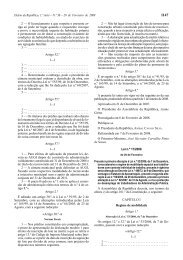
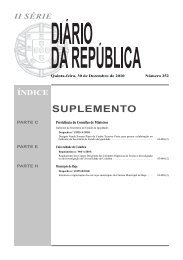
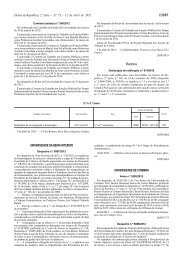
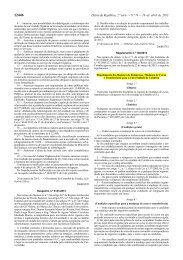
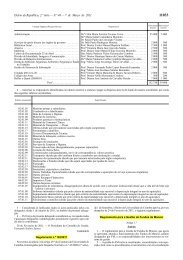
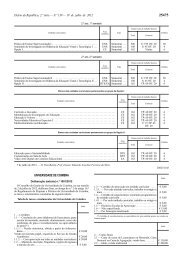
![RL #35 [quadrimestral. Julho 2012] - Universidade de Coimbra](https://img.yumpu.com/27430063/1/190x234/rl-35-quadrimestral-julho-2012-universidade-de-coimbra.jpg?quality=85)
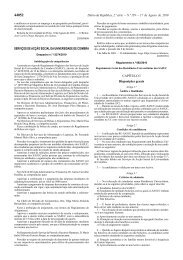
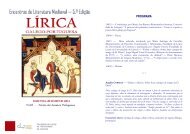
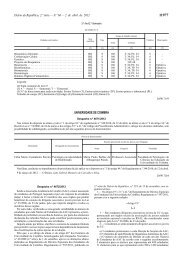
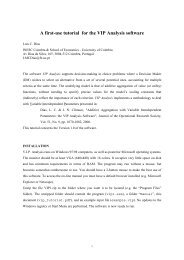
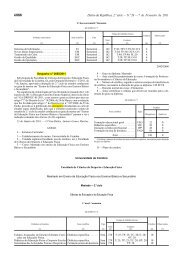

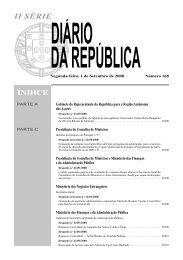
![RL #34 [quadrimestral. Março 2012] - Universidade de Coimbra](https://img.yumpu.com/27430022/1/190x234/rl-34-quadrimestral-marao-2012-universidade-de-coimbra.jpg?quality=85)